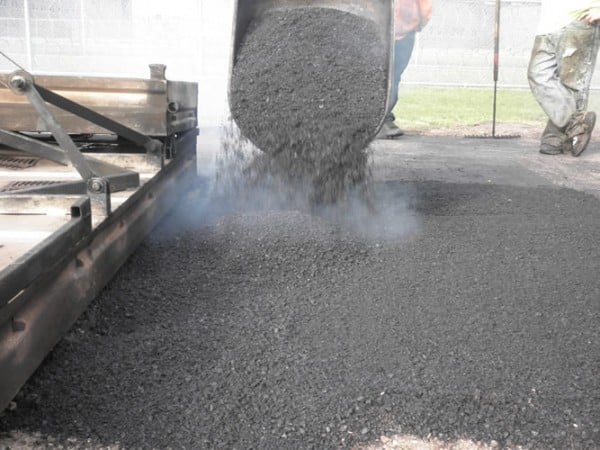Hot Mix Asphalt Paving: Your Portal to Costs Angled Parking Solutions
Hot Mix Asphalt Paving: Your Portal to Costs Angled Parking Solutions
Blog Article
Opening the Tricks of Warm Mix Asphalt Modern Technology
Discovering the depths of hot mix asphalt technology discovers a globe where thorough procedures and precise formulations converge to form our roadways and framework. The blend of fillers, aggregates, and binders isn't merely a construction task yet a critical orchestration of resilience and efficiency. As we peer right into the detailed dancing of elements, a tapestry of durability and sustainability unravels. What lies beneath this surface area of asphaltic proficiency, and what keys wait to be unveiled in the realm of paving technologies?
Significance of Warm Mix Asphalt
Hot Mix Asphalt plays an important role in contemporary infrastructure growth due to its longevity and cost-effectiveness. As the most generally utilized paving product for roads, highways, and parking area, Warm Mix Asphalt provides an array of benefits that contribute to its importance in building tasks. One key benefit is its capacity to endure rush hour loads and extreme climate condition, supplying a long-lasting and trustworthy surface area for transport networks. In Addition, Hot Mix Asphalt is cost-effective in both preliminary building and construction and lasting maintenance, making it a preferred option for several infrastructure projects.
The longevity of Warm Mix Asphalt originates from its make-up, that includes accumulations, binder, and filler products that are meticulously picked and blended to satisfy certain performance requirements. This exact mix leads to a strong and flexible sidewalk that can sustain constant usage without considerable deterioration. Warm Mix Asphalt is 100% recyclable, more improving its sustainability and environmental benefits. Overall, the relevance of Warm Mix Asphalt in facilities development can not be understated, as it remains to be a keystone of contemporary building methods.
Components of Asphalt Mixes
The structure of asphalt blends is composed of carefully selected accumulations, binder, and filler products that are crucial for accomplishing certain efficiency needs. Aggregates are the primary element of asphalt mixes, supplying toughness and security. The binder, typically bitumen or asphalt cement, holds the aggregates with each other and gives adaptability and resilience to the mix.
The mix and proportion of these components play a significant role in identifying the high quality and efficiency of the asphalt mix. Engineers very carefully make the mix to fulfill particular demands, thinking about aspects like website traffic volume, environment conditions, and sidewalk life-span. Correct choice and harmonizing of accumulations, binder, and fillers are essential for producing resilient, lasting asphalt pavements.
Mixing and Manufacturing Techniques

As soon as the accumulations are chosen, the binder, usually asphalt cement, is contributed to bind the products with each other. The binder's quality and quantity substantially affect the mix's adaptability, stamina, and resistance to environmental factors. In addition, fillers like moisturized lime or Rose city cement may be integrated to boost details characteristics of the asphalt mix, such as its workability or dampness resistance.
Throughout manufacturing, the aggregates and binder are heated, typically in between 250-325 ° F(121-163 ° C ), to promote blending and make sure appropriate covering of the aggregates. The blending procedure should be comprehensive to achieve an uniform blend that promotes the wanted efficiency attributes of the asphalt. Various techniques, such as set mixing or drum blending, are utilized to achieve regular and top notch asphalt blends for building and construction jobs.
Factors Influencing Asphalt Performance
Factors affecting asphalt performance include a variety of variables that influence the toughness, longevity, and overall top quality of asphalt pavements. One vital aspect is the quality of materials used in the asphalt mix. The type and resource of aggregates, the binder top quality, and the additives all play a significant function in determining the efficiency of the asphalt sidewalk. The gradation of accumulations is essential as it influences the mix's resistance, stability, and workability to rutting and cracking.

Environmental problems also influence asphalt efficiency. Temperature variants, moisture seepage, and traffic lots can all affect the structural integrity of the pavement. see this here Layout considerations, such as sidewalk thickness and drain, are important in guaranteeing the lasting performance of the asphalt pavement. By meticulously considering these engineers, specialists and factors can maximize asphalt efficiency and enhance the service life of pavements.
Lasting Practices in Asphalt Modern Technology

WMA enables for the manufacturing and placement of asphalt blends at lower temperatures contrasted to conventional hot-mix asphalt, resulting in lowered energy usage and greenhouse gas emissions. The use of porous asphalt mixes can aid reduce stormwater drainage issues by enabling water to penetrate through the sidewalk and right into the ground, promoting natural water purification and recharge processes.
Verdict
To conclude, hot mix asphalt explanation innovation plays a crucial role in contemporary facilities growth as a result of its resilience and cost-effectiveness. By very carefully stabilizing parts, using correct mixing strategies, and thinking about different elements, designers can develop top notch asphalt blends that stand up to rush hour tons and rough climate condition. Welcoming lasting techniques, such as utilizing recycled products and warm-mix innovations, further enhances the ecological kindness of asphalt innovation.
Mixing and production techniques in warm mix asphalt modern technology include the accurate combination and handling of aggregates, binder, and fillers to create a high-performance and sturdy asphalt mix.Aspects influencing asphalt performance incorporate a variety of variables that impact the resilience, long life, and general quality of asphalt sidewalks. Sustainable techniques in asphalt innovation encompass numerous efforts aimed at lowering the environmental influence of asphalt manufacturing and paving processes. By integrating reclaimed asphalt sidewalk (RAP) and recycled asphalt roof shingles (RAS) right into new asphalt blends, the market can considerably lower the usage of raw products and energy, while additionally you could check here reducing landfill waste.
WMA permits for the production and positioning of asphalt mixes at reduced temperature levels contrasted to traditional hot-mix asphalt, resulting in minimized energy usage and greenhouse gas exhausts.
Report this page